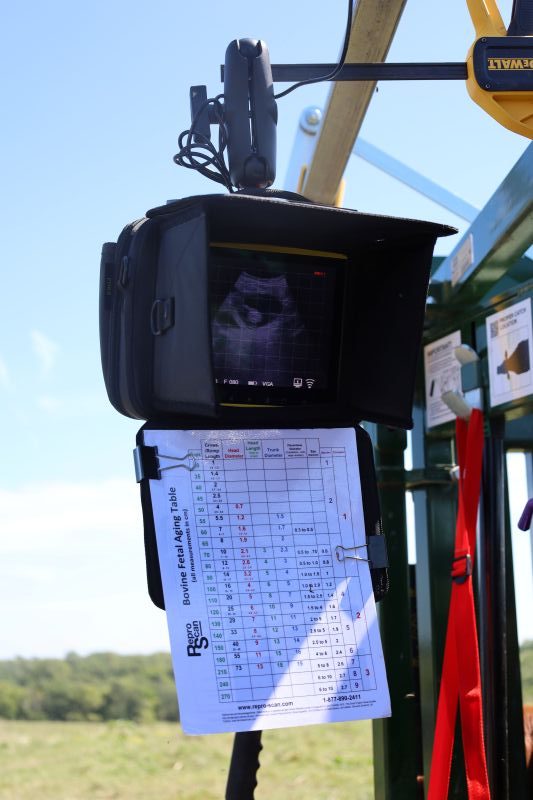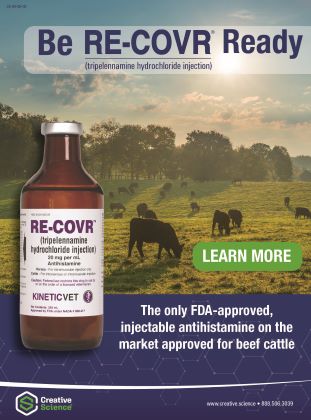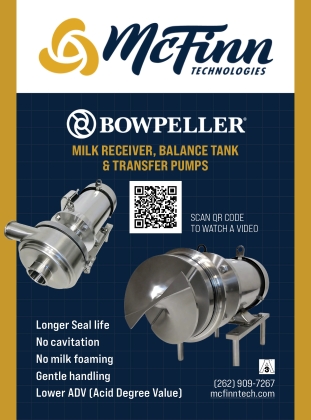Scans for Pregnancy and Reproductive Health

Reproduction Scans for Pregnancy and Reproductive Tract Health
Dairy producers try to keep close track of their cows and replacement heifers regarding readiness to breed, cycles, stage of pregnancy, etc. because it is very important to keep lactating cows at peak lactation as much as possible, with no long periods of low milk production between pregnancies. There are several ways to monitor these cattle, especially for pregnancy diagnosis.
Adrian A. Barragan, DVM, MS, PhD (Associate Research Professor and Extension Veterinarian, Department of Veterinary and Biomedical Sciences at Penn State University) says the two methods of pregnancy diagnosis that have been utilized for a long time are palpation and ultrasound. “Those two methods are both very accurate. The main difference between ultrasound and palpation is that with ultrasound you can determine the viability of the embryo and detect pregnancy a little earlier,” he says.
“With palpation you can’t differentiate between a live embryo and a dead one; you cannot assess heartbeat. So that’s one of the main advantages of ultrasound. When it’s a herd that is solely being checked with palpation, I recommend doing a second check
(after the first one at 45 days) at about 60 days, to make sure that the cow is still pregnant,” he says.
“Most veterinarians will be able to diagnose pregnancy by about 28 days after breeding, with ultrasound. With palpation some veterinarians are able to reliably detect pregnancy by 35 days, but the standard for palpation is 45 days. We generally consider 28 to 35 days with ultrasound and 35 to 45 days with palpation, in terms of how soon a person can accurately determine pregnancy,” says Barragan.
When it comes to diagnosing pregnancy, usually the main goal is not to find the pregnant animals, but to find the open ones. “Those are the ones we want to identify as soon as possible, so the dairy can get them rebred as quickly as possible,” he explains.
A third method of pregnancy detection is a blood test. This can detect pregnancy-associated glycoproteins (PAGs). Originally this was mainly of use in beef cattle, but dairies are starting to use it more. This test is very good for finding open animals because these proteins will show up if the animal gets pregnant, but the disadvantage is that the protein is still in the blood for a while if the embryo dies. “Those proteins remain high in the maternal blood circulation for up to 60 days. Thus you may get a lot of false positives with this test. However, this test can still be very useful to catch open cows as long as the cows that were diagnosed pregnant with the blood test are confirmed pregnant later with ultrasound or palpation,” he says.
“Another important thing when discussing a pregnancy diagnosis protocol for a dairy farm is the timing and number of pregnancy checks. Remember that the main goal is to determine open cows as quickly as possible. This would also include cows that lose their pregnancy due to embryonic loss or abortion. I recommend that each cow should have about three preg-checks before dry-off. The first one would be to diagnose pregnancy at the earliest timing based on the pregnancy diagnostic method utilized at the farm, another one between 90 and 120 days, and another one before five months. After five months the fetus and uterus have become so large it is unreachable via rectal palpation or ultrasound.” The heavy uterus drops down lower in the abdomen, below the pelvic rim, and can’t be reached by the veterinarian.
“Then every cow should have another check just before dry-off. That’s an easy palpation that can be done by the herd manager or producer, because a person can feel the large body parts of that calf if the cow is still pregnant. This is a reliable diagnostic protocol for dairy cows,” says Barragan.
The main goal is catching the open ones as soon as possible because no dairy wants the loss of production if the cow is past peak production (still being fed a lactation ration) and won’t be calving again very soon. You always want to get cows pregnant by the time they have been 120 days in milk, and sooner if possible. “The longer those cows remain open and you don’t know about it, the longer it will take for cows to get back to their peak lactation (most profitable time) in the subsequent lactation. One of the biggest issues of getting cows pregnant late, aside from the lower milk production once they are past peak lactation, is that if they are still eating a high-energy, starchy (and more expensive) diet, they will get fat,” he says.
“This is the perfect recipe for over-conditioned cows. Dairy cows that get fat by dry-off (more than 3.75 body condition score on a 1 to 5 scale) are at much higher risk for developing ketosis, and ketosis is one of the main reasons for infertility in cows. There is a high correlation between ketosis and low pregnancy rates, especially at first and second service, which is when you really want to get those cows pregnant.” This is a vicious cycle; the cow is too fat so she is prone to ketosis, which hinders conception, so the cow is still open and getting fatter again.
This often means that these cows are culled, and if they are still young cows with a lot of potential, that’s a tragedy. Thus it is very important to check for pregnancy early on and be able to rebreed the cow sooner rather than later if she is open.
Pregnancy checking is also important to identify twins early. Twinning in dairy cattle is very undesirable. “Twins are associated with many negative effects like dystocia and problems after calving. Cows with twins have higher rates of dystocia, stillbirths, retained placenta, metritis, poor reproductive performance later on, etc. So what I recommend is being very aggressive with twin pregnancies, which means identifying them as soon as possible and terminating the pregnancy. Then we can get that cow rebred as soon as possible,” says Barragan.
Some veterinarians in years past would just terminate one of the embryos, so the cow could continue the pregnancy with one embryo—as is often done with twins in mares. “But this is risky; studies have shown that in dairy cows terminating one embryo may cause inflammation that would affect the viability of the other embryo. And if the twins are in the same horn, it is very challenging to just terminate one without affecting the other one,” he explains.
Ultrasound has been used for many years in pregnancy diagnosis, and extension-arm probes have been in use for more than 20 years, making it easier on the veterinarian who is checking hundreds of cows. If a person is palpating cows or even putting your arm into each cow for ultrasound every day for 15 years, this is very hard on your arm and shoulder. The extension-arm probe can be useful in saving wear and tear on the person doing it.
“The probes are very useful for veterinary practitioners, but there could be some challenges when using them in certain situations. For instance, you cannot grab the uterus and feel various structures with your fingers. Some veterinarians retract the uterus a bit in every palpation, by grabbing the intercornual ligament (that connects the uterine horns), to pull the uterus above the pelvic floor and have easy access to all reproductive structures with the ultrasound. With a probe you wouldn’t be able to do this. There are some advantages to actually reaching in and screening all the internal organs of the reproductive tract,” says Barragan.
“We use ultrasound and palpation not only for preg-checking, but also for assessing the reproductive tract, uterine soundness, determining return to cyclicity after calving and evaluating stage of maturity in heifers. For instance, a few weeks after calving, when cows are ready for breeding, we can screen the ovaries and make sure there is a corpus luteum (CL) or a large follicle, and the uterus lumen to make sure there is no abnormal fluid. There are several situations in which we need to search for these structures and screen them either by palpation or ultrasound. This would be a little more challenging to do with a probe,” he says.
“The probe can be very useful for confirmation of pregnancy, however. By then the embryo or fetus is larger and much easier to find. Between 90 and 120 days, those pregnancies are really easy to find. The uterus is larger, there are placentomes (the specialized points of attachment between the maternal caruncle and the fetal cotyledon that form the functional unit of the cotyledonary placenta), a fetus, and a lot of good ‘black’ fluid inside the uterus (if you are using ultrasound), which is easy to see. In this situation the probe works great, but for the very early diagnostics at 28 days or so, and for uterine soundness or reproductive tract health examination, it can be a little more tricky to use it,” he says.
The ultrasound screens have been improving over the years. “They have improved in the small details, for instance, but there have been no major changes in recent years. My machine is five years old and is a remote unit that has a Bluetooth connection. I use it for research and teaching purposes and can connect it to up to four different devices; we use tablets. I have the goggles, but the students on the tablets can see exactly the same thing I am seeing,” he says.
“When I was in graduate school, I routinely helped as a veterinarian with the 4th- year veterinary students’ rotations, and we used some similar technology, but it was a separate big screen that you needed to purchase through the ultrasound company. You had to purchase the big screen along with the ultrasound machine and then you had a big plug that plugged into the ultrasound that would remotely connect to the screen. It was challenging, because the connection wasn’t great and you would lose the images if the students moved too far. In that aspect, the ultrasound screens have improved a lot,” he says.
At a certain stage in early pregnancy you can determine the sex of the calf with ultrasound. This is usually more important with beef cattle (such as in a purebred operation) than in dairy, however, because most dairies use sexed semen if they want to produce heifers. “With embryo transfer, however, this is still a popular technique. After 60 to 65 days of gestation you can determine the sex of the fetus. You look for the two hind legs and either the presence or absence of a scrotum. You need to handle the uterus a little to get the calf into a position where you can see this,” says Barragan. This would be a bit more challenging with a probe if you needed to handle the uterus. You might get lucky and find the fetus in the right position, but otherwise you may have trouble.
Most dairies don’t check the sex of the fetus, however, because their main focus is to determine if a cow is pregnant or open, so she could be rebred quickly and get back to milk production sooner. The best cows—the top 10 to 30%–are usually bred with sexed semen, to produce heifers, and the other cows are bred with either conventional or beef semen to have crossbred dairy-beef calves since they now have a good market for those. With the price of beef calves today, the dairies are getting a lot of money for those crossbred calves.
The actual number of heifers needed will depend on the dairy’s culling rate. “The higher the culling rate, the more replacements to require. However, thanks to the advances in fertility of sexed semen, dairies have more than enough replacement heifers these days, and are able to use a lot more beef semen today. This has become a profitable strategy because of the high prices they are getting for those crossbred calves,” he says.
By Heather Smith Thomas
November 2025
More Cattle Information here:
If you enjoy the Outdoors, The Iowa Sportsman



